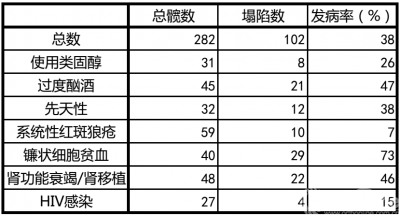系统综述:什么样的坏死情况更易引起股骨头塌陷?
2018-06-19 文章来源:304关节学术 作者:译者:肖凯 整理:骨科在线 点击量:704 我要说
无症状的股骨头坏死通常在有症状的对侧髋关节诊疗过程中而被发现。美国巴尔的摩西奈医院的Mont MA等人,通过对既往文献数据处理分析,发现无症状的股骨头坏死有较高的病情进展或股骨头塌陷风险,且不同坏死区域和范围也与塌陷风险的概率相关。
股骨头创伤性骨坏死在很多患者中表现为无症状,会引起股骨头的突然塌陷和髋关节迅速损坏。目前对无症状股骨头坏死的治疗还存在争议。有的作者认为其自然预后良好,有的作者报道超过50%的后期股骨头塌陷率。本研究作者旨在通过系统分析与无症状股骨头坏死相关的文献,分析其自然病程,评估股骨头塌陷情况,以寻找与其病情进展相关的影像学及人口统计学因素。
研究人员对无症状髋关节骨坏死的预后研究进行了全面文献检索,并从所有相关的研究中记录了人口统计学、放射学和结果数据。同时确定了发展成为症状性疾病和/或股骨头塌陷的发病率。随后根据病变大小、病变部位、影像学分期、相关的危险因素和/或疾病,以及研究的证据水平进行对结果进行统计分层。

图 由相关的危险因素和/或疾病引起股骨头塌陷的发病程度
结果显示,最终研究共纳入16篇文献,共包含664例髋。394例髋(59%)进展为有症状的股骨头坏死或发生股骨头塌陷。坏死区大小、坏死区位置、确诊时影像学分期均是影响自然病程预后的因素。坏死区较小、坏死区位于股骨头内侧的患者预后最好,其股骨头塌陷率<10%。镰状细胞贫血及系统性红斑狼疮病史患者的预后最好。
该项研究显示,坏死区范围较小、坏死区位于股骨头内侧的患者股骨头塌陷的概率较小。坏死范围中等,尤其是坏死范围较大的患者,病情进展或股骨头塌陷的风险较高。因此,作者建议股骨头坏死范围中等、偏大或坏死区位于外侧的无症状股骨头坏死患者接受保髋手术治疗,改善预后。
原文摘要
The Natural History of UntreatedAsymptomatic Osteonecrosis of the Femoral Head: A Systematic Literature Review
Background:
An asymptomatic hip withosteonecrosis is typically discovered as the contralateral hip of a patientwith one symptomatic joint. Treatment of the asymptomatic hip is controversial.While some authors claim a benign natura history, others have reported a rateof femoral head collapse exceeding 50%. The purpose of this report was tosystematically review the published literature regarding asymptomaticosteonecrosis of the femoral head to evaluate the overall prevalence ofprogression to symptomatic disease and/or femoral head collapse as well as todetermine whether various radiographic and demographic factors influenceprogression of the disorder.
Methods:
A comprehensive literature searchwas performed to identify prognostic studies evaluating asymptomatic hiposteonecrosis. Demographic, radiographic, and outcome data were extracted fromall relevant studies. The prevalence of progression to symptomatic diseaseand/or femoral head collapse was determined. Next, outcomes were stratified bylesion size, lesion location, radiographic stage, associated risk factorsand/or disease, and the level of evidence of the study.
Results:
Sixteen studies that included atotal of 664 hips were available for an analysis of outcomes. Overall, 394 hips(59%) had progression to symptoms or collapse. Differences in outcomes based onlesion size, lesion location, and radiographic stage at the time of diagnosiswere seen. Small, medially located lesions had the best prognosis, with aprevalence of collapse of <10%.Patients with sickle cell disease had thehighest frequency of progression, and those with a history of systemic lupuserythematosus had the most benign course.
Conclusions:
Data extracted from previouslypublished studies suggest that asymptomatic osteonecrosis has a high prevalenceof progression to symptomatic disease and femoral head collapse. While small,medially located lesions have a low rate of progression, the natural history ofasymptomatic medium-sized, and especially large, osteonecrotic lesions isprogression in a substantial number of patients. For this reason, it may bebeneficial to consider joint-preserving surgical treatment in asymptomaticpatients with a medium-sized or large, and/or laterally located, lesion.
文献出处:Mont MA , Zywiel MG , Marker DR , et al. The Natural History ofUntreated Asymptomatic Osteonecrosis of the Femoral Head: A SystematicLiterature Review. J Bone Joint Surg Am 2010 Sep;92 (12): 2165-70.





 京公网安备11010502051256号
京公网安备11010502051256号